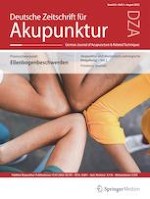Erschienen in:

12.05.2022 | Akupunktur | Review
Akupunktur und medizinisch-radiologische Bildgebung – Teil 2
Wert des funktionellen Neuroimaging (fMRT) in der Akupunkturforschung
verfasst von:
Prof. Dr. med. Uwe Schütz
Erschienen in:
Deutsche Zeitschrift für Akupunktur
|
Ausgabe 3/2022
Einloggen, um Zugang zu erhalten
Zusammenfassung
Es gibt erhebliche Überlappungen der zerebralen Schmerzmatrix innerhalb der Hirnnetzwerke, die sowohl mit der normalen Schmerzstimulation als auch mit der Akupunkturnadelstimulation verbunden sind. In den letzten Jahren wurden erhebliche Anstrengungen unternommen, um die anhaltende Wirkung der Akupunkturbehandlung wissenschaftlich zu stützen. Inwieweit hier die funktionelle Kernspintomographie (fMRT) die Erkenntnisse der zentralen Wirkungsweise der Akupunktur erweitern konnte, ist Thema dieser Übersichtsarbeit.
Die hämodynamisch-metabolischen Reaktionen des Gehirns auf die Akupunkturstimulation spiegeln sensorisch diskriminierende sowie kognitive und affektive Schmerzdimensionen wider. Störfaktoren wie Schmerzen, Emotionen, sensorische Einflüsse während der Akupunktur tragen zumindest teilweise zum Muster der Gehirnaktivität bei. Die zunehmende Anzahl an fMRT-Studien zeigt einen komplexen Wirkmechanismus der Akupunktur im Sinne einer Modulation der funktionellen Netzwerkkonnektivität zentraler Hirnnetzwerke auf: Aktivierungsmuster im kortikalen sensomotorischen Netzwerk und Ruhezustandsnetzwerk (Default Mode Network), in dessen antikorreliertem Netzwerk, Deaktivierungsmuster im limbisch-paralimbisch-neokortikalen Netzwerk und partiell auch Modulierungen in Hirnstamm, Cerebellum, subkortikalen und den Hippocampus-Hirnbereichen.
Die Akupunktur wirkt in verschiedenster Form modulierend auf die zentrale funktionelle Netzwerkkonnektivität ein und die zentrale Integration und neuronale Plastizität spielen eine entscheidende Rolle im Akupunkturmechanismus. Die Aktivierungs- und Deaktivierungsmuster, die nur für die Akupunkturstimulation relevant sind, sind aber bei Weitem noch nicht hinreichend spezifiziert.











